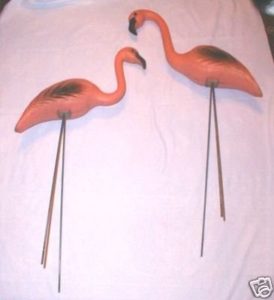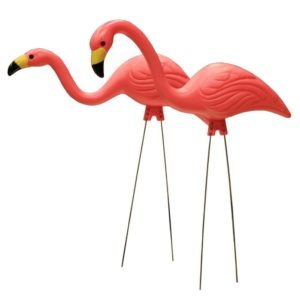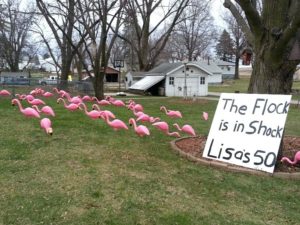
Sometimes, our childhood Boomer memories are of things that never went out of style, that continue to exist in an unchanged state today.
That is the fortunate case with plastic pink flamingos that our mothers would plant around the big concrete birdbaths in the back yards that we had. Odds are that you, or your kids, have a set of them that are pretty much identical to their 1950’s ancestors.
That’s because pink plastic flamingos have a staying power that transcends faddishness. Over their lifetimes, they have been gone from status symbols to tasteless icons of White Trash, and everywhere in between. But despite whatever social status they may have presented, they have always stubbornly existed in large numbers.
It all began with the building boom that existed with the pre-Depression economy of the 1920’s. Tens of thousands of real estate speculators and tourists headed to our “tropical” state: Florida. They spent their money on lots and beachfront property. Many brought home souvenirs bearing pictures of a bizarre pink bird that lived there – the flamingo.
Displaying flamingos implied that you, too, were a Florida investor. Everyone wanted flamingo decorations, and the American business machine was more than happy to provide them.
Wallpaper, gift wrapping paper, fabrics, product packaging, and much more began being decorated with images of pink flamingos.

But it wasn’t until 1952 that pink flamingos first ventured out into midwestern lawns. The Union Plastics Company of Massachusetts introduced a pink flamingo lawn ornament. The first ones were simply flat representations on a stick leg. Nothing too intriguing about that. They tried making three-dimensional styrofoam models the next year that sold better. However, if the yard in which they resided contained a dog or two, many of them were quickly shredded to bits by the playful canines.
Like the helpful uncle in The Graduate, a magic word popped up in Product Development: plastics.
The first atomic-pink molded plastic lawn flamingo went on sale in 1957. The brightly-colored durable birds were a smash hit, and millions of American housewives, including my own dear mother, went out and bought them. Many a 1960’s era photo of the back yard included the ubiquitous flamingos dutifully standing tall in the grass.

But as we drew into the 1970’s, the pink plastic flamingo began to take on an air of disgrace, not unlike the stereotypical black jockey ornaments also seen across white America. Indeed, pink flamingos were as White Trash as abandoned cars in the side yard.
That tone was picked up on by people who like to do what I do: stir the pot. If snooty neighbors looked down on pink plastic flamingos, there was only one thing to do: Go buy some!
Flamingos were back on the must-have list by the mid 80’s (with lots of help from the mega-popular Miami Vice), and have pretty much stayed there. Indeed, their trashy reputation they gained in the 70’s makes them more appealing than ever now. In fact, one of urban America’s most loved practical jokes is to “flock” your neighbor, i.e. put dozens of plastic pink flamingos in their front yard during the night. It’s a good-natured shock to their system when they step out in a bathrobe to get the morning paper and are confronted with a sea of pink birds.
Many towns have a business or two that specializes in the undercover planting of flocks of flamingos.
So here’s to a bit of Americana that has survived trendiness, the judgments of the self-righteous, and the test of time.